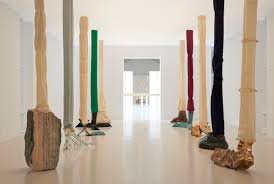Sharon Hecker at The Brooklyn Rail:
 Why, then, should we take a new look at Fabro? In my opinion, it is because of what he can tell us about the possibilities of sculpture.
Why, then, should we take a new look at Fabro? In my opinion, it is because of what he can tell us about the possibilities of sculpture.
Sculpture, for Fabro, was something that could be sensed, felt, touched, and tasted by the viewer. Before Félix González-Torres was piling up his candy installations, Fabro distributed sweets wrapped in messages, as part of an installation titled Computers di Luciano Fabro, Caramelle di Nadezda Mandelstam (Luciano Fabro’s Computers, Nadezhda Mandelstam’s Candies, 1990). The candies evoked a bitter memory, reported in Nadezhda’s memoirs, of the sweets that Stalin’s police cynically offered her while searching her apartment before sending her husband, the poet Osip Mandelstam, off to his death in a Siberian gulag.
For Fabro, sculpture was related to craft and to craftiness. He made his needle-and-thread Penelope (1972) out of leftover material from his enormous Piedi (Feet, 1968 – 71), which were adorned with silk stockings sewn by his seamstress mother.
more here.
